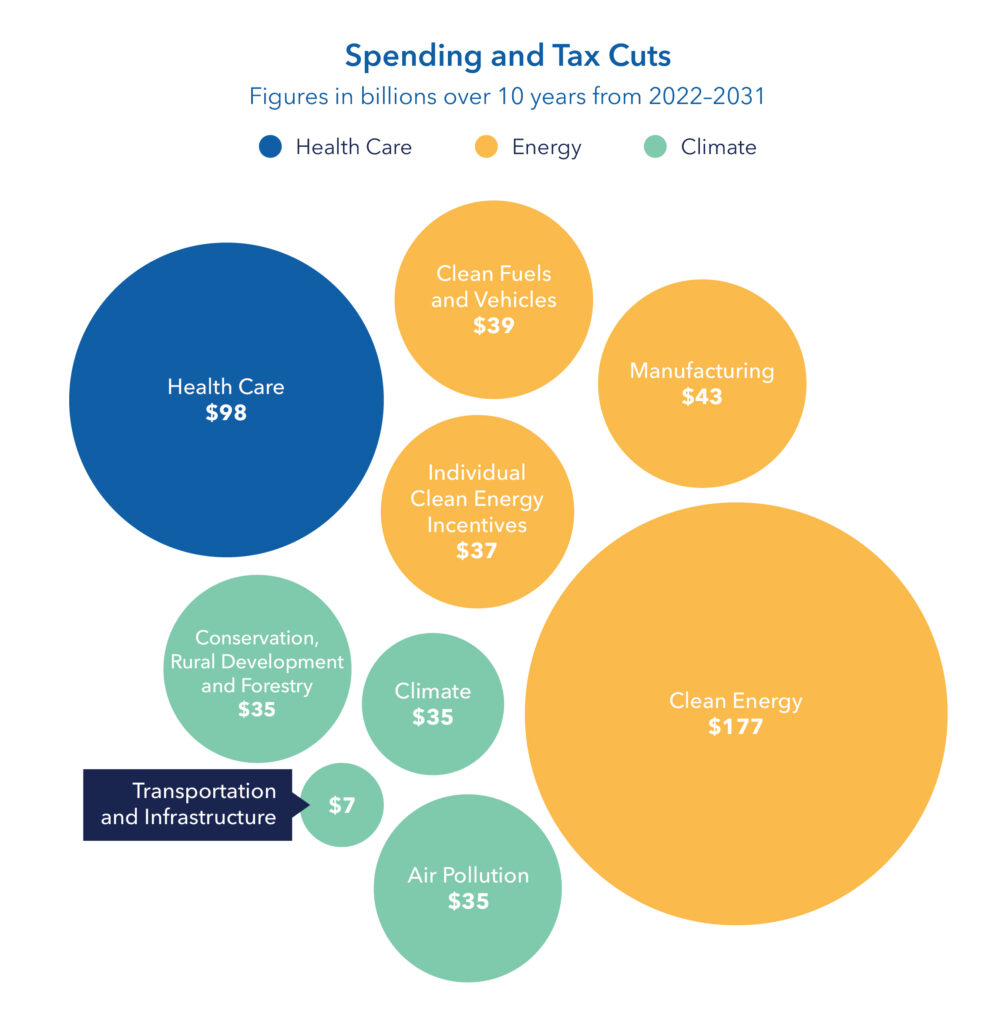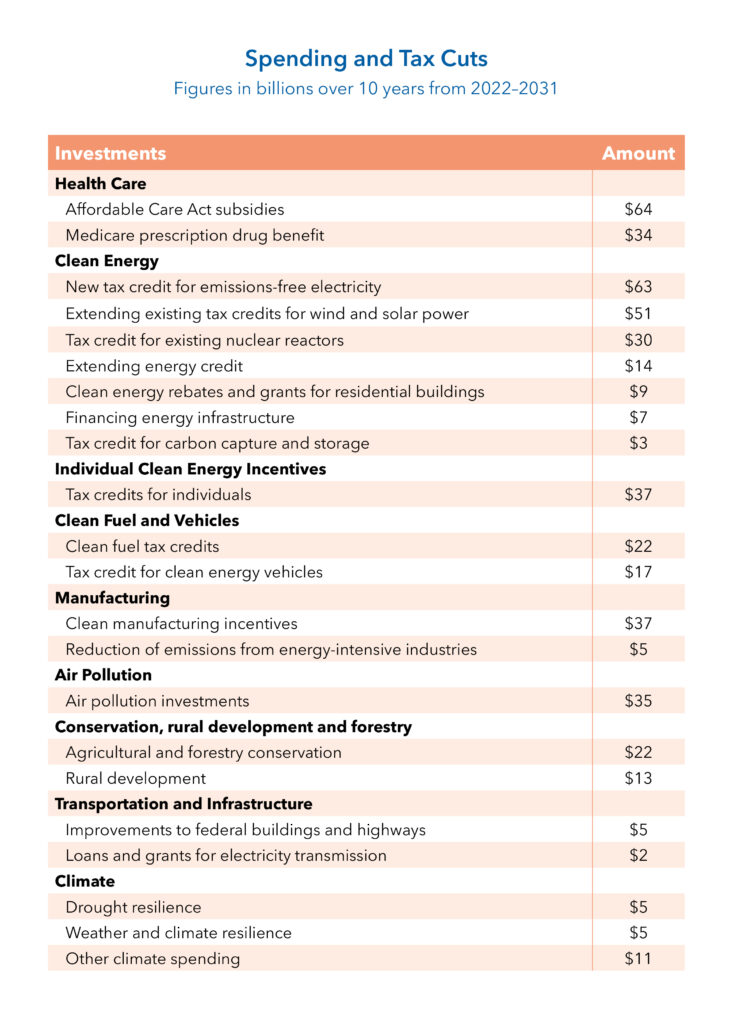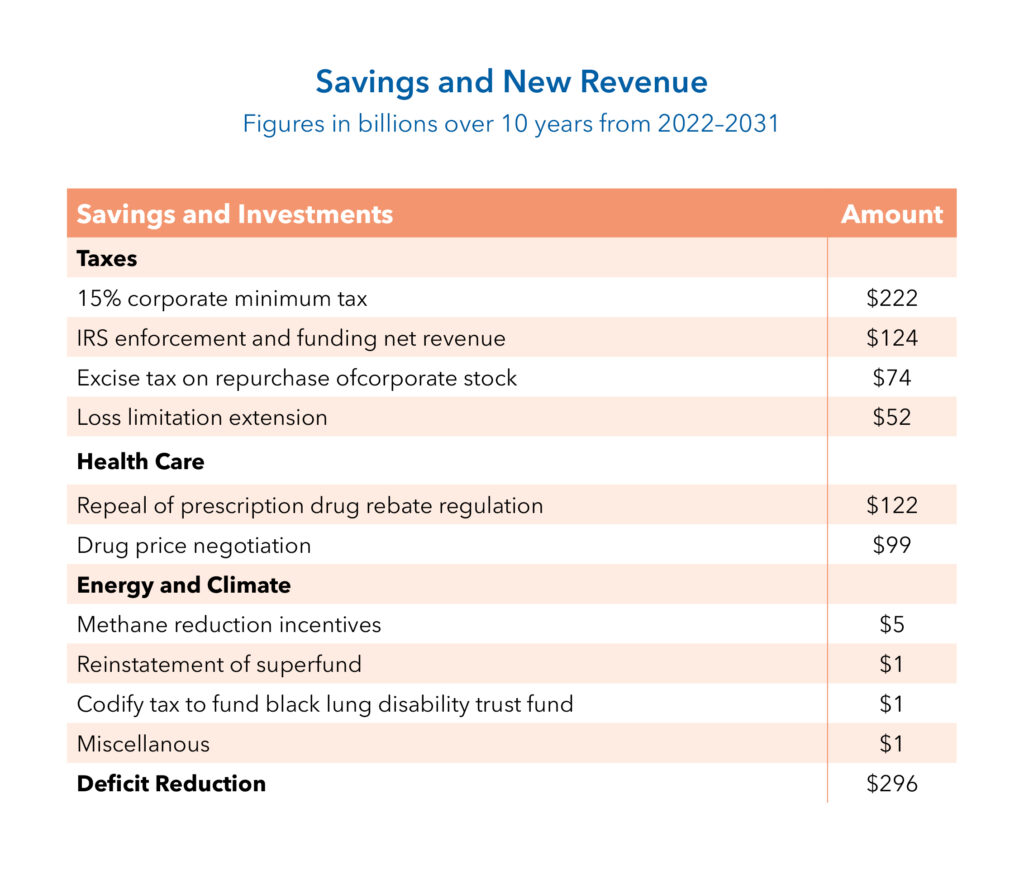CSG analysts have compiled elements of the bill that may directly impact states.


In August 2022, the U.S. Senate and U.S. House of Representatives approved the Inflation Reduction Act of 2022, and President Joe Biden signed the legislation into law on Aug. 16. The $773 billion legislation includes $433 billion of new investments in initiatives related to climate change, authorizes Medicare to negotiate pharmaceutical prices and implements various tax reform measures.
Footnote: Figures in billion and over 10 years (2022-2031)
Sources: Congressional Budget Office Cost Estimates, Joint Committee on Taxation Estimated Budget Effects, Senate Majority Leader Inflation Reduction Act Summary
The $433 billion in new investments include the following:
- Tax rebates and credits for households to lower energy costs and tax credits, loans and grants to increase the domestic production of wind turbines, solar panels, batteries and other energy production and storage. The bill also supports the creation of clean energy jobs and workforce development in disadvantaged communities.
- Tax credits to lower and middle-income families to encourage the sale of new and used electric vehicles.
- Authorization for Medicare to negotiate the prices of prescription drugs. The bill adjusts the annual cap Medicare enrollees pay for out-of-pocket costs for prescription drugs to $2,000 (the current cap is $7,050, with an unlimited 5% coinsurance on prescriptions after that cap is met).
- An extension of the temporary Premium Tax Credits of the Affordable Care Act through 2025. This is a refundable credit used to help low-income individuals and families cover premiums for their health insurance purchased through the marketplace. Under the new eligibility, households with income below 400% of the federal poverty line are eligible.
The Inflation Reduction Act will raise revenue by:
- Creating a 15% minimum tax on corporations with at least $1 billion in income.
- Investing $80 billion over 10 years to improve Internal Revenue Service enforcement for hiring and training new auditors, modernizing antiquated technology reliant on paper returns and improving taxpayer services.


In addition to the spending and policy changes broadly discussed in the media, CSG analysts have compiled elements of the bill that may directly impact state policymakers:
Agriculture
- Provides $125 million to provide services and supports to underserved farmers. (p. 555)
Energy
- Provides $9.7 billion to support the long-term resiliency, reliability and affordability of rural electric systems, in collaboration with rural cooperatives. (p. 552)
- Establishes the Alternative Fuel and Low-Emission Aviation Technology Program. This program includes competitive grants that state and local governments are eligible for, such as $245 million for projects relating to the production, transportation, blending or storage of sustainable aviation fuel and $47 million for projects relating to low-emission aviation technologies. (p. 577)
- Provides $4.3 billion for grants to state energy offices to carry out a Home Owner Managing Energy Savings (HOMES) tax rebate program, giving tax relief to homeowners who reduce their energy use by investing in “whole-house energy savings retrofits.” Rebates are based on the reduction in energy usage. (p. 584)
- Provides an additional $4.3 billion in grants to state energy offices to carry out the High-Efficiency Electric Home Rebate Program, giving tax relieve to homeowners who reduce electricity usage through appliance and non-appliance (e.g., insulation, wiring) upgrades. Rebates are based on purchase costs. (p. 593)
- Provides $200 million for states to develop training programs for contractors involved in the installation of home energy and electrification improvements. (p. 604)
- Provides $760 million for grants to state, local and tribal governments and other entities to support accelerated siting of interstate electricity transmission lines. (p. 619)
Environment
- Provides $700 million in competitive Forest Legacy Program grants to states for the acquisition of land. (p. 567)
- Provides $1.5 billion in competitive Urban and Community Forestry Assistance Program grants to public entities, including state, local and tribal governments. (p. 567)
- Provides $2.6 billion for coastal state, local and tribal local governments and other entities to support coastal community preparation for extreme weather. (p. 572)
- Provides $550 million for grants and other financial assistance to disadvantaged communities for the development of water supply projects. (p. 634)
- Provides $4 billion to mitigate the impact of droughts in Reclamation states. (p. 635)
- Provides $2.3 billion to state, local and tribal governments to reduce air pollution in ports. (p. 663)
- Provides $7 billion for competitive Greenhouse Gas Reduction Fund grants for state, local and tribal governments and other entities to support low-income and disadvantaged communities in benefiting from zero-emission technologies. (p. 667)
- Provides $8 billion for competitive grants to provide financial and technical assistance to low-income and disadvantaged communities to reduce greenhouse gas emissions. (p. 668)
- Provides $17 million for outreach and technical assistance to state, local and tribal governments related to greenhouse gas reduction resulting from domestic electricity generation. (p. 677)
- To reduce greenhouse emissions, the bill provides:
- $250 million for Greenhouse Gas Air Pollution Planning Grants.
- $4.7 billion for Greenhouse Gas Air Pollution Implementation Grants.
States and other public entities are eligible. (p. 694)
- Provides $2.8 billion in grant awards and $200 million for technical assistance for:
- “Community-led air and other pollution monitoring, prevention, and remediation, and investments in low- and zero-emission and resilient technologies and related infrastructure and workforce development that helps reduce greenhouse gas emissions and other air pollutants.
- Mitigating climate and health risks from urban heat islands, extreme heat, wood heater emissions, and wildfire events.
- Climate resiliency and adaptation.
- Reducing indoor toxics and indoor air pollution.
- Facilitating engagement of disadvantaged communities in State and Federal advisory groups, workshops, rulemakings, and other public processes.” (p. 699)
Tribal and local governments are eligible.
- Provides $121 million to address the impact of weather events on federal and state wildlife management areas. (p. 702)
- Provides $75 million for the Tribal Energy Loan Guarantee program.
Health Care
- Increases by 1% the Federal Medical Assistance Percentage for administering vaccines eligible under the Social Security Act. In other words, the bill increases the federal subsidy for the distribution of vaccines, including COVID-19. (p. 227)
- Permanently extends the tax rate to fund the Black Lung Disability Trust Fund. (p. 533)
Infrastructure
- Provides $1.9 billion to the Federal Highway Administration for the competitive neighborhood access and equity grant program to fund a variety of safety, environmental quality and transportation accessibility initiatives. States and other entities are eligible. (p. 704)
- Provides $1.3 billion for projects in economically disadvantaged communities. These projects are to be administered by state transportation departments. (p. 709)
Sources:
- https://www.finance.senate.gov/imo/media/doc/jct_distributional_effects_inflation_reduction_act.pdf
- https://www.taxpolicycenter.org/taxvox/putting-jcts-score-inflation-reduction-act-context
- https://www.democrats.senate.gov/imo/media/doc/inflation_reduction_act_one_page_summary.pdf
- https://budgetmodel.wharton.upenn.edu/issues/2022/7/29/inflation-reduction-act-preliminary-estimates
- https://www.crfb.org/blogs/whats-inflation-reduction-act




